Rafting the Upper Klamath River is possible through the summer thanks to releases of water from the J.C. Boyle Dam, which will be removed next year. When guides return to the Upper Klamath in 2025, this stretch of the river will be forever changed.
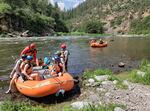
Rafters from Noah’s River Adventures from Ashland, Ore., depart from Spring Island for a float on the Upper Klamath River in June 2023.
Juliet Grable / JPR
At Spring Island, a popular put-in spot on the Upper Klamath River, a dozen or so whitewater rafters are getting ready to run a reach called Hell’s Corner Canyon. The thrill seekers adjust helmets and snug their life jackets as Nate McLennan, a rafting guide with Noah’s River Adventures, describes what they’ve signed up for.
“We’ve got two big Class Four-plus rapids: one called Caldera; one called Hell’s Corner,” says McLennan. “They’re going to be long, big, fast: lots of paddling; lots of grabbing on; lots of shifting around in the boat.”
McLennan covers safety next: what to do in case of an involuntary group swim; how not to club fellow passengers in the head with a paddle. While he talks, the other guides load gear and pump the inflatable rafts taut. By 10:00 a.m., trailers from three Rogue Valley rafting companies — Noah’s, Momentum River Expeditions, and Indigo Creek Outfitters — have swarmed the boat ramp.
The boats from Indigo Creek push off first. In one, the guide sits at the stern while his crew of four practices coordinated turns. Then they set off downriver, bumping over frothy riffles and past a jumble of basalt boulders before disappearing around the bend.
Bart Baldwin, who owns Noah’s, calls Hell’s Canyon a “giggle fest.” “The kids love it; the adults love it,” he says. “It’s just one after another after another after another of warm, splashing water.”
Guides like McLennan cut their teeth on the Upper Klamath; the run they’re doing today consists of 14 technical, hard-to-read miles and 42 named rapids.
“You know, the Rogue River is where you get a lot of your first paddle strokes,” says McLennan. “And then you come up here. This is where you really dial in all those techniques and skills, learning to run bigger river features.”
Spring Island is just downstream of the J.C. Boyle Dam and hydropower plant near the Oregon-California border. That this trip is possible through the summer is thanks to coordinated releases of water from the powerhouse. But J.C. Boyle, along with three other dams that are part of the Lower Klamath Project, will be removed next year, and the powerhouses decommissioned (the smallest of the four dams, Copco 2, has already been partially deconstructed). When guides return to the Upper Klamath in 2025, this stretch of the river will be forever changed.
A place at the table
The dirt-and-gravel road to Spring Island passes by J.C. Boyle’s power-generating infrastructure: a “power canal” diverts water from upriver into massive twin pipes, or penstocks, that swoop hundreds of feet downslope to two power-generating turbines enclosed in squat metal cylinders. The power plant has greater capacity than any other in the Lower Klamath Project, which together produce enough power to support about 70,000 homes.
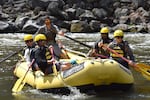
Rafters with Indigo Creek Outfitters from Phoenix, Ore. take their first paddle strokes after departing from Spring Island on the Upper Klamath River in June 2023.
Juliet Grable / JPR
During the rafting season, the controlled release of water from the plant pumps the river’s volume up to between 1500 and 1700 cubic feet per second. These daily pulses are timed to peak mid-morning, when boats put in at Spring Island.
“It’s the same every day in summer,” says Pete Wallstrom, who owns Momentum River Expeditions. “May 1 through October, we know exactly what’s going to happen.” This consistency allows guides to learn the big water, making it safe to take a wide range of passengers down the run.
Offering this trip when people are looking for relief from summer heat has been a huge advantage, says Baldwin.
“That warm water, hot weather, big water—that’s the combination we’ll lose,” he says.
Although “river rats” are generally friends of wild rivers, local guides and outfitters will be giving up one of their biggest draws when the Klamath River dams are removed. Right now, the Hell’s Canyon trip represents about 50% of Noah’s business and one third of Momentum’s. Once the dams are gone, outfitters may still be able to run commercial trips on the Upper Klamath in spring, when flows are naturally high. But when the volume dwindles, it will be too risky to expose loaded rafts to the sharp volcanic rocks.
The owners of Noah’s, Momentum, and Indigo Creek, which account for the vast majority of commercial traffic on the Upper Klamath, formed the Upper Klamath Outfitters Association in 2005 to ensure they had a voice in the process as plans for dam removal inched forward. While they made an early decision to support dam removal, they’ve also been clear about what’s at stake for their businesses.
“We’ll have this season, and then we’ll have a season with no business and then we’ll have to rebuild on the new stretches,” says Wallstrom. “We understand this needs to happen for dam removal, but it’s also a challenge.”
Outfitters won’t be able to run the Upper Klamath at all in 2024, while the reservoirs are being drawn down and the dams deconstructed. Even as deconstruction begins, the outfitters have been adamant about not giving up their final season as they brace for the hit to their businesses next year.
This spring, they negotiated with the Klamath River Renewal Corporation, which is overseeing dam removal, on a compromise: they agreed to give up a week in June and to cut their season short in the fall so that Kiewit, the deconstruction contractor, can prepare for the drawdowns, which will begin in January.
“At this point it’s been a little bit of back and forth, but they hear us and they’ve conceded some things as well,” says Baldwin. “And so I believe we’re on track for a really good last year up there.”
The timing of the drawdowns was chosen to minimize the impact of sediment in the water for fish and spawning. Meeting that deadline is critical, says Mark Bransom, CEO of KRRC. “It’s important to note that if we are not prepared to undertake drawdown of the reservoirs in the January timeframe, we could very well lose an entire year.”
A new era of recreation
For decades, PacifiCorp maintained campgrounds, picnic areas, and boat ramps around the dam reservoirs. KRRC has already begun closing some of these; meanwhile, they are planning five new recreation sites with the help of GreenWorks, a Portland-based landscape architecture firm, and input from area tribes, residents, outfitters, fishing groups, and the states of California and Oregon.
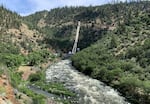
Large pipes or “penstocks” that transfer water from the J.C. Boyle Dam to the J.C. Boyle powerhouse where two turbines generate electricity. The facility is operated by PacifiCorp and is one of four hydroelectric dams on the Klamath River that will be removed over the next year and a half.
Juliet Grable / JPR
The designers are considering everything from parking and accessibility to cultural resources, says Paul Agrimis, principal landscape architect at GreenWorks. “We are also thinking a lot about climate change and providing shade as we have hotter, dryer summers.”
Sites will include wheelchair-accessible fishing platforms, water-conserving toilets, and landscaping that blends with the restored reservoir footprints. Locations were chosen to steer visitors away from sensitive tribal cultural sites and to provide access to fishing and whitewater runs, some of them newly exposed or invigorated.
The powerhouse site below J.C. Boyle Dam will be revamped as Moonshine Falls. This new recreation site will serve as the take-out for the Upper Big Bend run, which is currently hidden under the J.C. Boyle reservoir, and the put-in for the Big Bend run, where water is currently diverted to feed the hydropower plant.
KRRC has landed a $3.5 million grant from the California Wildlife Conservation Board for the design and construction of the three new sites in California. One of these, called Copco Valley, will serve as the put-in for a new whitewater run called Ward’s Canyon.
KRRC will do some work to reduce hazards in Ward’s Canyon, which flows through a scenic basalt gorge between Copco 1 and Iron Gate dams. For decades, this section was dewatered to help feed the Copco 2 powerhouse. Now, cottonwoods clog the river channel.
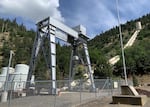
The J.C. Boyle Dam powerhouse on the Upper Klamath River is one of four dam facilities that will be removed in 2024.
Erik Neumann / JPR
“We’re going to remove a significant amount of vegetation,” says Bransom. “We’re going to break up some large boulders and try to reposition those to improve safety and boating conditions.”
Ward’s Canyon will make for a short but exhilarating run, with several Class 3 and 4 rapids stacked one on top of another. Because of its easy access and proximity to Interstate 5, it’s likely to be popular with commercial and private boaters alike.
“There’ll be something that’s open that has never been open to commercial whitewater boating,” says Baldwin, who has run Ward’s Canyon a few times. It’s fun, but short, he says, “It’s not as big and technical as the Hell’s Corner reach.”
In 2020, KRRC, PacifiCorp, and boaters collaborated on a “flow study”: PacifiCorp released water from J.C. Boyle to simulate different flow conditions; rafters and kayakers ran sections of the river and reported back on the potential hazards and opportunities.
Without the dams, the Klamath River will run free for 250 miles to the ocean, possibly opening up new options for multi-day trips. But though the study gave outfitters a taste of what’s to come, they won’t really know what some of these runs are like — in particular, the ones that are submerged under the reservoirs — until the dams are removed. Baldwin and Wallstrom aim to get their boats back on the Upper Klamath as soon as possible in 2025 so they can learn the new runs and start marketing trips.
Witnessing history
The one-day trips that local outfitters run through Hell’s Canyon last most of the day. Guides draw out the experience by pulling the boats ashore above the first big rapid and pausing halfway for lunch.
This stretch of Wild and Scenic river is special not just for its exhilarating rapids, but because of its remoteness: no roads and few people, but you’re almost guaranteed to spy bald eagles and ospreys soaring above.
“Rivers allow you to see a certain area from a much different perspective than you might normally hiking on a ridge looking down upon it,” says McLennan. “You’re floating on the lowest point in the valley looking back up on everything.”
Wallstrom says that so far, the 2023 season has been their best ever. He hopes people will seek out the new Klamath River trips in 2025 — not just to support local rafting companies, but so they can witness the healing river.
“I’m just so excited to see a healthier Klamath River,” says Wallstrom. “Hell’s Canyon is an incredible way to introduce people to whitewater, but at the same time what allows that is very unhealthy for the river, and we love rivers.”
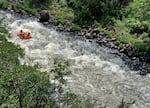
A raft from Noah’s River Adventures hitting the first small rapids after departing from Spring Island on the Upper Klamath River in June 2023.
Erik Neumann / JPR